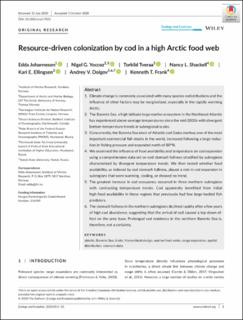Resource‐driven colonization by cod in a high Arctic food web
Johannesen, Edda; Yoccoz, Nigel; Tveraa, Torkild; Schackell, Nancy L.; Ellingsen, Kari; Dolgov, Andrey V.; Frank, Kenneth T.
Peer reviewed, Journal article
Published version
Permanent lenke
https://hdl.handle.net/11250/2719605Utgivelsesdato
2020Metadata
Vis full innførselSamlinger
- Articles [3012]
- Publikasjoner fra CRIStin [3070]
Originalversjon
10.1002/ece3.7025Sammendrag
1. Climate change is commonly associated with many species redistributions and the influence of other factors may be marginalized, especially in the rapidly warming Arctic. 2. The Barents Sea, a high latitude large marine ecosystem in the Northeast Atlantic has experienced above-average temperatures since the mid-2000s with divergent bottom temperature trends at subregional scales. 3. Concurrently, the Barents Sea stock of Atlantic cod Gadus morhua, one of the most important commercial fish stocks in the world, increased following a large reduction in fishing pressure and expanded north of 80°N. 4. We examined the influence of food availability and temperature on cod expansion using a comprehensive data set on cod stomach fullness stratified by subregions characterized by divergent temperature trends. We then tested whether food availability, as indexed by cod stomach fullness, played a role in cod expansion in subregions that were warming, cooling, or showed no trend. 5. The greatest increase in cod occupancy occurred in three northern subregions with contrasting temperature trends. Cod apparently benefited from initial high food availability in these regions that previously had few large-bodied fish predators. 6. The stomach fullness in the northern subregions declined rapidly after a few years of high cod abundance, suggesting that the arrival of cod caused a top-down effect on the prey base. Prolonged cod residency in the northern Barents Sea is, therefore, not a certainty. abiotic, Barents Sea, biotic, hierarchical design, marine food webs, range expansion, spatial distribution, stomach data
